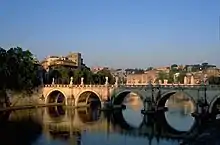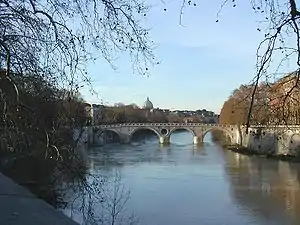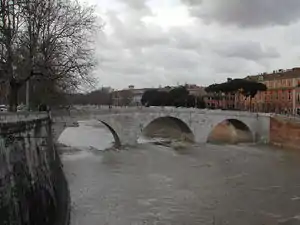Liste der Tiberbrücken in Rom
In Rom befinden sich zahlreiche Brücken, die über den Tiber oder seine Zuflüsse führen. Eine Vielzahl dieser Brücken stammt aus antiker Zeit oder es handelt sich um Neubauten an Stelle antiker Brücken. Die bekannteste Brücke ist die Engelsbrücke, die direkt zur Engelsburg führt.

Engelsbrücke

Milvische Brücke

Ponte Sisto

Pons Cestius
.JPG.webp)
Ponte Sublicio
Hier eine Liste der Tiberbrücken in Rom – flussabwärts von Norden nach Süden:
- Ponte di Castel Giubileo (1951)
- Ponte di Tor di Quinto (1960)
- Ponte Flaminio (1932–1951)
- Ponte Milvio (207 v. Chr.; im Mittelalter „Ponte Mollo“ genannt)
- Ponte Duca d’Aosta (1939–1942)
- Ponte della Musica (2008–2011)
- Ponte del Risorgimento (1911)
- Ponte Matteotti (1929; vor 1945 „Ponte delle Milizie“ bzw. „Ponte Littorio“ genannt)
- Ponte Pietro Nenni (1971–1972)
- Ponte Regina Margherita (1886–1891; auch kurz „Ponte Margherita“ genannt)
- Ponte Cavour (1891–1896)
- Ponte Umberto I (1885)
- Ponte Sant’Angelo (Engelsbrücke), (134 n. Chr. als „Pons Aelius (Ponte Elio)“ bezeichnet)
- Ponte Vittorio Emanuele II (1886–1911; auch kurz „Ponte Vittorio“ genannt, an Stelle der "Pons Neronianus" errichtet)
- Ponte Principe Amedeo (1942, an Stelle der „Ponte dei Fiorentini“ errichtet)
- Ponte Mazzini (1904–1908)
- Ponte Sisto (1473–1479; ersetzte die römische „Ponte di Agrippa“, die auch „Ponte Aurelio“, „Ponte Antonino“ oder „Ponte di Valentiniano“ genannt und im Mittelalter als „Pons fractus“ oder „Pons ruptus“ bezeichnet wurde)
- Ponte Garibaldi (1888)
- Ponte Cestio (auch Ponte San Bartolomeo) an der Tiberinsel (Mitte des 1. Jh. v. Chr. als „Pons Cestius“ in Richtung rechtes Tiberufer errichtet)
- Ponte Fabricio an der Tiberinsel (62 v. Chr. als „Pons Fabricius“ in Richtung linkes Tiberufer errichtet)
- Fragmente der „Ponte Rotto“ (241 v. Chr. als „Pons Aemilius (Ponte Emilio)“ errichtet und im Mittelalter als „Ponte di Lepido“, „Ponte lapideo“, „Ponte dei Senatori“ oder „Ponte Maggiore“ bezeichnet; 1552 wiederaufgebaut und erneut 1573–1575)
- Ponte Palatino (1886–1891), volkstümlich auch als „Ponte inglese“ oder „Ponte degli inglesi“ bezeichnet, da durch eine ungewöhnliche Verkehrsführung auf der Brücke Linksverkehr besteht.
- Ponte Sublicio (1914–1919; auch als „Ponte Aventino“ bezeichnet)
- Ponte di Probo (eingestürzt, nur Reste der Fundamente erhalten)
- Ponte Testaccio (1940–1948)
- Ponte dell’Industria (1863; auch als „Ponte di San Paolo“ oder heute „Ponte di ferro“ bezeichnet, ursprünglich eine Eisenbahnbrücke)
- Ponte Marconi (1937–1954)
- Ponte della Magliana (1930–1948)
- Ponte Monumentale di Mezzocammino (1938)
- Ponte di Tor Boacciana („Ponte della Scafa“)
Siehe auch
Literatur
- Silvia Koci Montanari: Die antiken Brücken von Rom. 96 Seiten (illustr.), geb., 1. Aufl., Regensburg, Schnell & Steiner, 2006, ISBN 3-7954-1814-3
- Annamaria Ramieri: I Ponti di Roma. 295 Seiten (reich illustr.), Rom, Verlag Colombo, 2003, ISBN 88-86359-49-7 Inhalt (PDF)
Weblinks
Commons: Ponti di Roma – Album mit Bildern, Videos und Audiodateien
Commons: Bridges in Rome – Sammlung von Bildern, Videos und Audiodateien
- www.romaspqr.it (italienisch)
- Fotografien – www.studioargento.com
This article is issued from Wikipedia. The text is licensed under Creative Commons - Attribution - Sharealike. The authors of the article are listed here. Additional terms may apply for the media files, click on images to show image meta data.